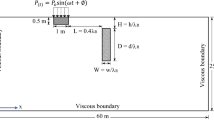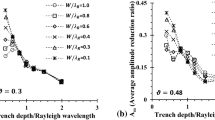Abstract
Underground train–induced vibrations can cause nearby residents discomfort, damage to buildings, and disturbance for equipment. One of the most effective ways to reduce vibrations is using wave barriers along the propagation path of the waves. Many parameters are involved in determining the efficiency of these barriers: the barrier’s dimension, distance from the source of vibration, and material property, to name a few. Simultaneous study of these parameters is complex since numerical analysis of alternatives is time-consuming. Therefore, in this study, by coupling the three-dimensional finite element method and an optimization algorithm, an attempt is made to provide a comprehensive solution to find the optimal wave barriers for Tehran metro line 4 as a case study. The current study evaluates two strategies: using in-filled trenches and topology-optimized barriers. In the first strategy, results show that soft-material trenches with maximum depth close to the observation point have the best performance. Further investigations on jet grout trenches show better performance in stiffer soil and lower train speed. Using dual trenches improves performance only up to 2%, so it does not provide a suitable option. For various practical reasons, there may be no tendency to use soft-material trenches, which perform well in vibration reduction. Therefore, in the second strategy, the improvement of a hard trench (jet grout) performance by topology optimization is investigated. According to this study, topology optimization is an effective method for improving barrier performance.
































Similar content being viewed by others
Data availability
The data that support the findings of this study are available from the corresponding author, upon reasonable request.
References
ABAQUS (2014) Analysis User’s Manual, Version 6.14. Dassault Systemes Simulia, Inc.
Abedini F, Rafiee-Dehkharghani R, Laknejadi K (2022) Mitigation of vibrations caused by dynamic compaction considering soil nonlinearity. Int J Civ Eng. https://doi.org/10.1007/s40999-022-00700-9
Al-Hussaini T, Ahmad S (1996) Active isolation of machine foundations by in-filled trench barriers. J Geotech Eng 122:288–294
Alzawi A, El Naggar MH (2011) Full scale experimental study on vibration scattering using open and in-filled (GeoFoam) wave barriers. Soil Dyn Earthq Eng 31:306–317
Andersen L, Nielsen SR (2005) Reduction of ground vibration by means of barriers or soil improvement along a railway track. Soil Dyn Earthq Eng 25:701–716
Balendra T, Chua K, Lo K, Lee S (1989) Steady-state vibration of subway-soil-building system. J Eng Mech 115:145–162
Baziar MH, Kazemi M, Shahnazari H (2019) Mitigation of ground vibrations induced by high speed railways using double geofoam barriers: centrifuge modeling. Geotext Geomembr 47:712–728
Bordón J, Aznárez J, Schevenels M, Maeso O, Lombaert G (2018) Shape optimized inclined single and double wall wave barriers for ground vibration mitigation. Soil Dyn Earthq Eng 112:215–231
Çelebi E, Kırtel O (2013) Non-linear 2-D FE modeling for prediction of screening performance of thin-walled trench barriers in mitigation of train-induced ground vibrations. Constr Build Mater 42:122–131
Çelebi E, Fırat S, Beyhan G, Çankaya İ, Vural İ, Kırtel O (2009) Field experiments on wave propagation and vibration isolation by using wave barriers. Soil Dyn Earthq Eng 29:824–833
Chan CM, Zhang L, Ng JT (2009) Optimization of pile groups using hybrid genetic algorithms. J Geotech Geoenviron Eng 135:497–505
Chen Y, Feng Q, Liu Q, Jiang J (2021) Experimental study on the characteristics of train-induced vibration in a new structure of metro depot. Environ Sci Pollut Res 28:41407–41422. https://doi.org/10.1007/s11356-021-13599-x
Chopra AK (2007) Dynamics of Structures. Pearson Education. https://books.google.de/books/about/Dynamics_of_Structures.html?id=0dU1bDaRyP4C&redir_esc=y
Coulier P, Cuéllar V, Degrande G, Lombaert G (2015) Experimental and numerical evaluation of the effectiveness of a stiff wave barrier in the soil. Soil Dyn Earthq Eng 77:238–253
Croce P, Flora A, Modoni G (2014) Jet grouting: technology, design and control. CRC Press. https://books.google.de/books?hl=en&lr=&id=E53AAgAAQBAJ&oi=fnd&pg=PP1&dq=jet+grouting+technology+design+and+control+bibliography&ots=mN219DfnuU&sig=SH7TMYbb0PHCMpkJFgmPRPqlZQ
Edil TB, Bosscher PJ (1994) Engineering properties of tire chips and soil mixtures. Geotech Test J 17:453–464
Ekanayake SD, Liyanapathirana D, Leo CJ (2014) Attenuation of ground vibrations using in-filled wave barriers. Soil Dyn Earthq Eng 67:290–300
Elragi AF (2000) Selected Engineering Properties and Applications of EPS Geofoam. State University of New York. College of Environmental Science and Forestry, Syracuse, NY. https://books.google.de/books/about/Selected_Engineering_Properties_and_Appl.html?id=X6zntgAACAAJ&redir_esc=y
Forrest J, Hunt H (2006) A three-dimensional tunnel model for calculation of train-induced ground vibration. J Sound Vib 294:678–705
François S, Schevenels M, Thyssen B, Borgions J, Degrande G (2012) Design and efficiency of a composite vibration isolating screen in soil. Soil Dyn Earthq Eng 39:113–127
Groenwold AA, Etman L (2010) A quadratic approximation for structural topology optimization. Int J Numer Meth Eng 82:505–524
Gupta S, Liu W, Degrande G, Lombaert G, Liu W (2008) Prediction of vibrations induced by underground railway traffic in Beijing. J Sound Vib 310:608–630
Hansen N, Auger A (2014) Evolution strategies and CMA-ES (covariance matrix adaptation), Proceedings of the Companion Publication of the 2014 Annual Conference on Genetic and Evolutionary Computation, pp. 513–534. https://doi.org/10.1145/2598394.2605347
Hussein M, François S, Schevenels M, Hunt H, Talbot J, Degrande G (2014) The fictitious force method for efficient calculation of vibration from a tunnel embedded in a multi-layered half-space. J Sound Vib 333:6996–7018
Jiang Y, Meng F, Chen Y, Zheng Y, Chen X, Zhang J, Huang X (2020) Vibration attenuation analysis of periodic underground barriers using complex band diagrams. Comput Geotech 128:103821. https://doi.org/10.1016/j.compgeo.2020.103821
Koziol P, Mares C, Esat I (2008) Wavelet approach to vibratory analysis of surface due to a load moving in the layer. Int J Solids Struct 45:2140–2159
Kuhlemeyer RL, Lysmer J (1973) Finite element method accuracy for wave propagation problems. J Soil Mech Found Div 99:421–427
Li X, Hu Z, Zou C (2022) Noise annoyance and vibration perception assessment on passengers during train operation in Guangzhou Metro. Environ Sci Pollut Res 29:4246–4259. https://doi.org/10.1007/s11356-021-15896-x
Li Z, Ma M, Liu K, Jiang B (2023) Performance of rubber-concrete composite periodic barriers applied in attenuating ground vibrations induced by metro trains. Eng Struct 285:116027. https://doi.org/10.1016/j.engstruct.2023.116027
Lombaert G, Degrande G, François S, Thompson D (2015) Ground-borne vibration due to railway traffic: a review of excitation mechanisms, prediction methods and mitigation measures. Noise and vibration mitigation for rail transportation systems, 253–287. https://doi.org/10.1007/978-3-662-44832-8_33
Lysmer J, Kuhlemeyer RL (1969) Finite dynamic model for infinite media. J Eng Mech Div 95:859–877
Mahdavisefat E, Salehzadeh H, Heshmati A (2018) Full-scale experimental study on screening effectiveness of SRM-filled trench barriers. Géotechnique 68:869–882
Masad E, Taha R, Ho C, Papagiannakis T (1996) Engineering properties of tire/soil mixtures as a lightweight fill material. Geotech Test J 19:297–304
Meng L, Shi Z, Hao S, Cheng Z (2023) Filtering property of periodic in-filled trench barrier for underground moving loads. Constr Build Mater 400:132655. https://doi.org/10.1016/j.conbuildmat.2023.132655
Metrikine A, Vrouwenvelder A (2000) Surface ground vibration due to a moving train in a tunnel: two-dimensional model. J Sound Vib 234:43–66
Moghadam AE, Rafiee-Dehkharghani R (2021) Optimal design of wave barriers in dry and saturated poroelastic grounds using covariance matrix adaptation evolution strategy. Comput Geotech 133:104015
Moghadam AE, Rafiee-Dehkharghani R (2022a) Wave barriers for mitigation of underground train vibrations in the layered grounds considering the groundwater table effect. Constr Build Mater 348:128629
Moghadam AE, Rafiee-Dehkharghani R (2022b) Ground-borne vibration screening in layered dry and saturated grounds using optimal inclined wave barriers. Soil Dyn Earthq Eng 162:107448
Nanni E, Oberhuber J, Froldi P (2004) L’utilizzo della metodologia jet grouting per l’ampliamento e la ristrutturazione di edifici esistenti (in ambito urbano), Proceedings of the 22nd National Geotechnical Conference, pp. 403–407
Nejati HR, Ahmadi M, Hashemolhosseini H (2012) Numerical analysis of ground surface vibration induced by underground train movement. Tunn Undergr Space Technol 29:1–9
Nguyen T, Ghabraie K, Tran-Cong T (2015) Simultaneous pattern and size optimisation of rock bolts for underground excavations. Comput Geotech 66:264–277
Qu S, Zhao L, Yang J, Wu Z, Zhu S, Zhai W (2023) Numerical analysis of engineered metabarrier effect on ground vibration induced by underground high-speed train. Soil Dyn Earthq Eng 164:107580. https://doi.org/10.1016/j.soildyn.2022.107580
Sadeghi S, Abedini F, Rafiee-Dehkharghani R, Laknejadi K (2021) Covariance matrix adaptation evolution strategy for topology optimization of foundations under static and dynamic loadings. Comput Geotech 140:104461. https://doi.org/10.1016/j.compgeo.2021.104461
Shen S-L, Wu H-N, Cui Y-J, Yin Z-Y (2014) Long-term settlement behaviour of metro tunnels in the soft deposits of Shanghai. Tunn Undergr Space Technol 40:309–323
Sun X, Ma M, Jiang B, Cao R (2022) Ground vibration from freight railway: environmental impact and potential mitigation measure at propagation path. Environ Sci Pollut Res 29:44364–44377. https://doi.org/10.1007/s11356-022-18955-z
Tasalloti A, Chiaro G, Murali A, Banasiak L (2021) Physical and mechanical properties of granulated rubber mixed with granular soils—a literature review. Sustainability 13:4309
Thompson D, Jiang J, Toward M, Hussein M, Ntotsios E, Dijckmans A, Coulier P, Lombaert G, Degrande G (2016) Reducing railway-induced ground-borne vibration by using open trenches and soft-filled barriers. Soil Dyn Earthq Eng 88:45–59
Thompson D (2008) Railway noise and vibration: mechanisms, modelling and means of control. Elsevier. https://doi.org/10.1016/B978-0-08-045147-3.X0023-0
Toraldo C, Modoni G, Ochmański M, Croce P (2018) The characteristic strength of jet-grouted material. Geotechnique 68:262–279
Van Hoorickx C, Sigmund O, Schevenels M, Lazarov BS, Lombaert G (2016) Topology optimization of two-dimensional elastic wave barriers. J Sound Vib 376:95–111. https://doi.org/10.1016/j.jsv.2016.04.039
Van Hoorickx C, Schevenels M, Lombaert G (2017) Double wall barriers for the reduction of ground vibration transmission. Soil Dyn Earthq Eng 97:1–13. https://doi.org/10.1016/j.soildyn.2017.02.006
Transportation and Construction Vibration Guidance Manual (2013). https://dot.ca.gov/programs/environmental-analysis/noise-vibration/guidance-manuals
Woods RD (1968) Screening of surface wave in soils. J Soil Mech Found Div 94:951–979
Xu Q, Xiao Z, Liu T, Lou P, Song X (2015) Comparison of 2D and 3D prediction models for environmental vibration induced by underground railway with two types of tracks. Comput Geotech 68:169–183
Yang W, Hussein M, Marshall A (2013) Centrifuge and numerical modelling of ground-borne vibration from an underground tunnel. Soil Dyn Earthq Eng 51:23–34
Yarmohammadi F, Rafiee-Dehkharghani R, Behnia C, Aref A (2018) Topology optimization of jet-grouted overlapping columns for mitigation of train-induced ground vibrations. Constr Build Mater 190:838–850
Yarmohammadi F, Rafiee-Dehkharghani R, Behnia C, Aref A (2019) Design of wave barriers for mitigation of train–induced vibrations using a coupled genetic-algorithm/finite-element methodology. Soil Dyn Earthq Eng 121:262–275
Yuan Z, Xu C, Cai Y, Cao Z (2015) Dynamic response of a tunnel buried in a saturated poroelastic soil layer to a moving point load. Soil Dyn Earthq Eng 77:348–359
Yuan Z, Wu J, Sun H, Cai Y, Zou C (2023) Practical back-analysis methodology to predict underground train-induced building vibrations. Environ Sci Pollut Res 30:58697–58715. https://doi.org/10.1007/s11356-023-26389-4
Zoccali P, Cantisani G, Loprencipe G (2015) Ground-vibrations induced by trains: filled trenches mitigation capacity and length influence. Constr Build Mater 74:1–8
Author information
Authors and Affiliations
Contributions
SS: data curation, investigation, resources, software, validation, and writing original draft. RR-D: conceptualization, data curation, investigation, methodology, resources, supervision, validation, writing (original draft, review, and editing). KL: data curation, investigation, methodology, resources, supervision, and validation. All authors read and approved the final manuscript.
Corresponding author
Ethics declarations
Ethical approval and consent to participate
The presented research does not involve any human participants and/or animals.
Consent for publication
All authors whose names appear on the submission:
(1) made substantial contributions to the conception or design of the work; the acquisition, analysis, or interpretation of data; or the creation of new software used in the work;
(2) drafted the work or revised it critically for important intellectual content;
(3) approved the version to be published; and
(4) agree to be accountable for all aspects of the work in ensuring that questions related to the accuracy or integrity of any part of the work are appropriately investigated and resolved.
Competing interests
The authors declare no competing interests.
Additional information
Responsible Editor: Philippe Garrigues
Publisher's Note
Springer Nature remains neutral with regard to jurisdictional claims in published maps and institutional affiliations.
Rights and permissions
Springer Nature or its licensor (e.g. a society or other partner) holds exclusive rights to this article under a publishing agreement with the author(s) or other rightsholder(s); author self-archiving of the accepted manuscript version of this article is solely governed by the terms of such publishing agreement and applicable law.
About this article
Cite this article
Sadeghi, S., Rafiee-Dehkharghani, R. & Laknejadi, K. Three-dimensional optimization of wave barriers for mitigating ground vibrations induced by underground train. Environ Sci Pollut Res 31, 384–405 (2024). https://doi.org/10.1007/s11356-023-31218-9
Received:
Accepted:
Published:
Issue Date:
DOI: https://doi.org/10.1007/s11356-023-31218-9




